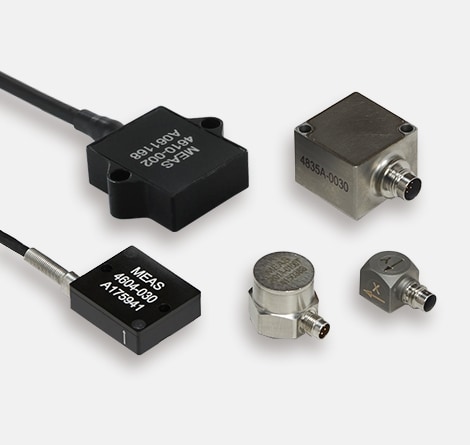
MEMS DC Accelerometers
A MEMS accelerometer is DC coupled, and can respond to frequencies as low as 0Hz. MEMS DC response accelerometers can measure static or very low frequency (<1Hz) acceleration, or if velocity and displacement information are to be extracted from the acceleration data.

DC Response

Static Measurements

Low Frequency to 0Hz
DC RESPONSE ACCELEROMETER TYPES
Capacitive Accelerometers
Capacitive type accelerometers are based on the capacitance changes in the seismic mass under acceleration and is the most common technology used for accelerometer today. These accelerometers employ Micro Electro Mechanical Systems (MEMS) fabrication technology which can bring economy of scale to high volume applications, hence lower manufacturing cost. One inherent characteristic with all capacitive devices is its internal clock. The clock frequency (~500kHz) is an integral part of the current detection circuit, which is invariably present in the output signal due to internal leakage. The high frequency noise may well be outside of the acceleration measurement range of interest, but it is always there with the signal. Due to its built-in amplifier/IC, its 3-wire (or 4- wire for differential output) electrical interface is straight forward, requiring only a stable DC voltage source for power.
The bandwidth of a capacitive accelerometer is mostly limited to a few hundred Hz, though some design can offer up to 1500Hz partly due to its physical geometry and heavy gas damping. Capacitive sensor structure is suitable for the lower range of acceleration measurement. Maximum range is typically limited to less than 200g. Modern capacitive accelerometers, especially the instrument grade devices, offer good linearity and high output stability.
Capacitive type accelerometers are most suitable for on-board monitoring applications where cost may be the driving factor. They are suited for measuring low frequency motion where the g level is also low, such as vibration measurements in civil engineering.

Piezoresistive Accelerometers
Piezoresistive is the other commonly used sensing technology for DC-response accelerometers. Instead of sensing the capacitance changes in the seismic mass (as in a capacitive device), a piezoresistive accelerometer produces resistance changes in the strain gauges that are part of the accelerometer’s seismic system. The output of most piezoresistive designs is generally sensitive to temperature variation. It is necessary to apply temperature compensation to its output internally or externally. Modern piezoresistive accelerometers incorporate ASIC for all forms of on board signal conditioning, as well as in- situ temperature compensation.
The bandwidth of piezoresistive accelerometers can reach upwards of 7,000 Hz. Many of the piezoresistive designs are either gas damped (MEMS types) or fluid damped (bonded strain gauge type). Damping characteristics can be an important factor in choosing an accelerometer. In applications where the mechanical input may contain very high frequency input (or excite high frequency response), a damped accelerometer can prevent sensor ringing (resonance) and preserve or improve dynamic range. Because the piezoresistive sensor output is differential and purely resistive, signal to noise performance is generally outstanding; its dynamic range is limited only by the quality of the DC bridge amplifier. For very high g-shock measurements, some piezoresistive designs can handle acceleration levels well above 10,000g.
Due to its broader bandwidth capability, piezoresistive type accelerometers are most suitable for impulse/impact measurements where frequency range and g-level are typically high. Being a DC-response device, one can accurately derive from its acceleration output the desired velocity and displacement information without integration error. Piezoresistive accelerometers are commonly used in automotive safety testing, weapons testing, and higher shock range measurements beyond the usable range of VC accelerometers.

Applications
- Condition monitoring
- Wind turbines
- Automotive safety testing
- High speed rail and mass transit
- Flight testing
- Seismic and structure monitoring
